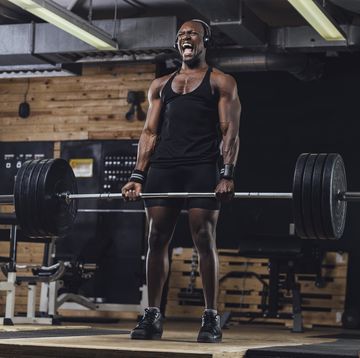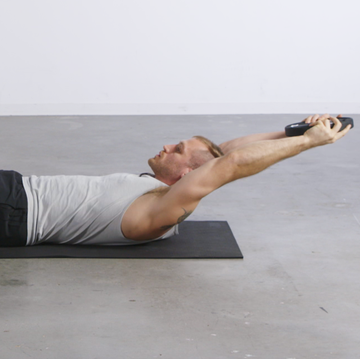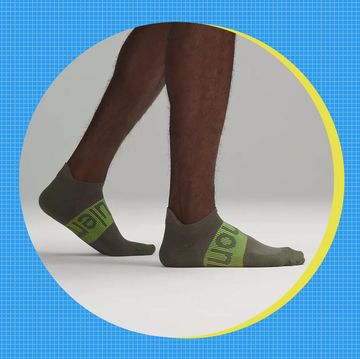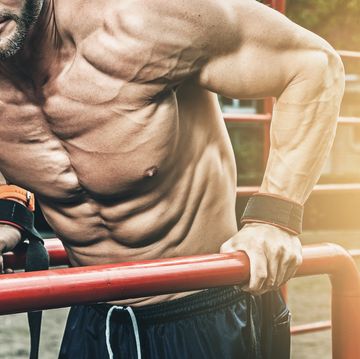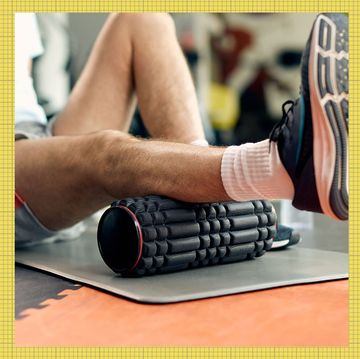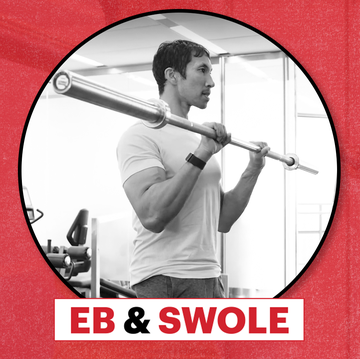Television sports announcers and pro scouts all seem to agree on one thing: You can't teach size. But they're dead wrong.
Any man can build muscle size if he's working out the right way, says Michael Mejia, C.S.C.S., mastermind of our new yearlong workout series. In this month's installment, you'll not only make your muscles bigger, but do it faster than ever before, too.
Phase 2 of this program makes use of a technique called supersetting, in which you perform two sets of two different exercises back-to-back, without rest in between.
Beginners do supersets for opposite muscle groups--chest and back, say. One muscle group rests while the other works, allowing you to pack twice as much exercise into the same workout for a more vigorous weight-lifting session. The intermediate/ advanced program uses compound sets featuring different exercises for the same muscles, without resting. This produces a deeper level of muscular exhaustion, and a more potent muscle-building stimulus.
So take a look at this workout plan and get to work. You're going to teach your muscles how to grow, and you'll find they're quick learners. Muscle 101 is officially in session.
Download the logs!
Excel
Word Doc
About this Series
If you belong to a gym, you can do the workouts exactly as shown here. Or, if you prefer, you can replace machine exercises with the barbell or dumbbell version. If you work out at home, you can choose the barbell or dumbbell option, or add a multistation home gym and do the workout. The gear you'll need:
Barbell Option
1. A barbell set with plenty of extra weights. We recommend starting with a 300-pound Olympic barbell set (that total weight includes the 45-pound bar). You can get one at fitness factory.com for $100.
2. A bench that supports bench presses and squats (in other words, the uprights are adjustable so you can use them for either exercise), or a power rack (a steel cage that allows you to do squats and bench presses safely).
3. A chinup bar. This can be a bar that fits over your door frame or twists into it. If you have a power rack and enough headroom, the top crossbar is good for chinups and pullups. Or you can buy a freestanding chinup/dip station.
4. A Swiss ball. You don't absolutely need it, but it will add challenge and variety to a number of exercises throughout the series.
Dumbbell Option
1. Fixed or adjustable dumbbells. Most men will need to start at 10 pounds and go up to at least 50 pounds for each dumbbell. That means at least 100 pounds of weight plates if you're using adjustable dumbbells. You also want most of those weights to be 10s and 5s, since it's awkward to do dumbbell exercises with larger plates.
2. A bench that inclines and declines.
3. A chinup bar, described above.
4. A Swiss ball.
Full-Home-Gym Option
1. A multistation home gym, or a home cable station that has high and low pulleys.
2. The full barbell setup described above. (If you opt for the power rack, you can add a cable attachment for a couple hundred dollars and do without the multistation machine.)
3. The dumbbell equipment described above.
4. A chinup bar, as described above, plus a dip station. You can get dip attachments for many multistation home gyms, power racks, and benches with adjustable uprights.
5. A Swiss ball.
Which Workout To Do
Choose the Beginner workout if you have less than a year of strength-training experience, or if you're coming back from a layoff longer than 4 months. Choose the Intermediate/Advanced if you've worked out consistently for the past year or longer.
How To Use The Training Logs
Record the weight used and repetitions completed with good form for each set of each exercise. For example, if you're doing the Beginner workout and you do 10 repetitions of bent-over rows with 65 pounds for your first set, you'd write 65/10 in the appropriate box. Fair warning: The boxes are small; use a fine-point pen.
Download the logs!
Excel
Word Doc
Exercise Equipment provided by Fitness Factory.
Weights provided by Irongrip.
Video clips require the QuickTime.
Related Products: Alternate between Workout A (upper body) and Workout B (lower body) each workout, 3 days a week. So you'll perform Workout A twice the first week (on Monday and Friday, for instance) and Workout B once (on Wednesday). The following week, you'll do Workout B on Monday and Friday and Workout A on Wednesday. Do eight to 12 repetitions of each exercise in a superset -- a pair of exercises that work opposite muscle groups -- with no rest between exercises. After completing both exercises, rest 90 seconds, and repeat one or two times, for a total of two or three sets of each exercise. Then rest for 90 seconds and begin the exercises in the next superset.
Beginner Workout A
Upper Body
Grab a barbell with a shoulder-width, overhand grip. Stand with your feet shoulder-width apart and knees slightly bent. Bend at your hips, lowering your torso about 45 degrees, and let the bar hang straight down from your shoulders.
Pull the bar up to your torso, pause, then slowly lower it.
Alternate: Dumbbell Bent Over Row
Grab a pair of dumbbells and lie on your back on a bench set to a low incline (15 to 30 degrees). Lift the dumbbells up at arm's length so they're over your chin, and hold them with your palms turned toward your feet (thumbs facing each other). Slowly lower the weights to your upper chest, pause, then push them back up over your chin.
Alternate: Barbell Incline Bench Press
Sit on a bench while holding a pair of dumbbells just outside your shoulders, with your arms bent and palms facing each other. Push the weights straight overhead, pause, then slowly lower the
Alternate: Barbell Shoulder Press
Grab the parallel bars on a dip station and lift yourself so that your arms are fully extended. Bend your knees and cross your ankles behind you. Slowly lower your body by bending your elbows until your upper arms are parallel to the floor. Pause, then push yourself back to the starting position. Superset with chin-ups (do the exercises back to back; rest after completing a set of each), shown below.
Note: Use a weighted belt if you can do more than the recommended repetitions.
Alternate: Dumbbell Close-Grip Bench Press and Barbell Close-Grip Bench Press
Lie on your back on the floor with your fingertips behind your ears, your knees bent and feet flat on the floor. Keep your elbows pulled back so that they're in line with your body, and slowly lift your torso to a sitting position. Pause, then slowly lower your torso to the floor.
Lower Body
Set a bar on a squat rack and step under it so the bar rests across your upper back. Pull your shoulders back as you grab the bar with an overhand grip. The bar should sit comfortably on your upper trapezius. Lift the bar off the rack and step back. Your feet should be shoulder-width apart, knees slightly bent, back straight, and eyes focused straight ahead.
Slowly lower your body as if you were sitting back into a chair, keeping your back in its natural alignment and lower legs nearly perpendicular to the floor. When your thighs are parallel to the floor, pause, then return to the starting position.
Alternate: Dumbbell Squat
Swiss-Ball Hip Extension and Leg Curl
Lie on your back on the floor and place your lower legs on a Swiss ball. Put your hands flat on the floor at your sides. Push your hips up so that your body forms a straight line from your shoulders to your knees. Without pausing, pull your heels toward you and roll the ball as close as possible to your butt. Pause, then reverse the motion -- roll the ball back until your body is in a straight line, then lower your back to the floor and repeat.
Alternate: Lying Hip Extension
Position yourself in a leg-press machine with your back against the pad and your feet about 4 inches apart on the platform. Unlock the platform and slowly lower the weight until your knees are bent 90 degrees. Pause, then push the weight back up to the starting position.
Alternate: Barbell Hack Squat and Dumbbell Hack Squat
Start in the same position as for the barbell squat. Slowly bend forward at the hips as you lower your chest as far as you can go while maintaining the natural arch in your lower back, or until your upper body is parallel to the floor. Keep your head up and maintain about the same angle of your knees. Lift your upper body back to the starting position.
Alternate: Barbell Good Morning/Dumbbell Good Morning
Barbell Standing Calf Raise
Grab a barbell with an overhand grip and place it so that it rests comfortably across your upper back. Stand on the balls of your feet on a block or step. Lower your heels as far as you can, then rise up on your toes as high as you can. Pause, then slowly lower your heels.
Alternate: Dumbbell Standing Calf-Raise
Lie on a slant board with your hips lower than your head. Grab the bar behind your head for support. Bend your hips and knees 90 degrees. Pull your hips upward and crunch them inward, as if you were emptying a bucket of water resting on your pelvis. Keep your hips and knees at 90-degree angles. Pause, then slowly lower your hips to the starting position.
Do Workout A and Workout B twice each week. Perform Workout A first in the week, and then do Workout B the following day. Rest a day or two, then repeat the workout sessions. So you might do Workout A on Monday and Thursday, and Workout B on Tuesday and Friday. Do 6 to 10 repetitions of each exercise in a compound set-pairs of exercises that work the same muscle group-with no rest between exercises. After completing both exercises, rest 90 seconds, and repeat one to two times, for a total of two or three sets of each exercise. Then rest 90 seconds and begin the exercises in the next superset.
Upper Body
Grab a barbell with a shoulder-width, overhand grip. Stand with your feet shoulder-width apart and knees slightly bent. Bend at your hips, lowering your torso about 45 degrees, and let the bar hang straight down from your shoulders. Pull the bar up to your torso, pause, then slowly lower it.
Alternate: Dumbbell Bent Over Row
Hang from the parallel chinup bars using an overhand grip, with your palms facing each other. Cross your ankles behind you. Pull yourself up until your chest is as close to your hands as possible. Pause, then slowly lower yourself to the starting position.
Alternate: Dumbbell Pullover and Barbell Pullover
Swiss-Ball Dumbbell Incline Bench Press
Grab a pair of dumbbells and position yourself on your back on a Swiss ball so your torso is at a 45-degree angle to the floor. Hold the dumbbells just outside your shoulders at about jaw level, with your palms facing forward. Press the dumbbells overhead so that the weights are above your chin at the top of the move. Slowly lower the dumbbells to the starting position.
Alternate: Barbell Incline Bench Press
Grab the parallel bars on a dip station and lift yourself so that your arms are fully extended. Bend your knees and cross your ankles behind you. Slowly lower your body by bending your elbows until your upper arms are parallel to the floor. Pause, then push yourself back to the starting position. Superset with chin-ups (do the exercises back to back; rest after completing a set of each), shown below. Note: Use a weighted belt if you can do more than the recommended repetitions.
Alternate: Dumbbell Close-Grip Bench Press and Barbell Close-Grip Bench Press
Grab a barbell with a shoulder-width, overhand grip. Stand holding the barbell in front of you at shoulder level, your feet shoulder-width apart and knees slightly bent. Push the weight straight overhead, leaning your head back slightly but keeping your torso upright. Pause, then slowly lower the bar to the starting position.
Alternate: Dumbbell Shoulder Press
Cable Upright Row
Attach an EZ-curl bar to the low pulley of a cable station. Stand facing the weight stack and grab the bar with a shoulder-width, overhand grip. Hold the bar at arm's length in front of your thighs. Pull the bar up until your upper arms are parallel to the floor. Pause, then slowly lower the bar to the starting position.
Alternate: Barbell Upright Row and Dumbbell Upright Row
Lower Body
Set a bar on a squat rack and step under it so the bar rests across your upper back. Pull your shoulders back as you grab the bar with an overhand grip. The bar should sit comfortably on your upper trapezius. Lift the bar off the rack and step back. Your feet should be shoulder-width apart, knees slightly bent, back straight, and eyes focused straight aheady.
Slowly lower your body as if you were sitting back into a chair, keeping your back in its natural alignment and lower legs nearly perpendicular to the floor. When your thighs are parallel to the floor, pause, then return to the starting position.
Alternate: Dumbbell Squat
Position yourself in a leg-press machine with your back against the pad and your feet about 4 inches apart on the platform. Unlock the platform and slowly lower the weight until your knees are bent 90 degrees. Pause, then push the weight back up to the starting position.
Alternate: Barbell Lunge or Dumbbell Lunge
Grab a barbell with an overhand grip and place it so that it rests comfortably across your upper back. Slowly bend forward at the hips as you lower your chest as far as you can go while maintaining the natural arch in your lower back, or until your upper body is parallel to the floor. Keep your head up and maintain the same angle of your knees. Lift your upper body back to the starting position.
Alternate: Good Morning with dumbbells
Swiss-Ball Hip Extension and Leg Curl
Lie on your back on the floor and place your lower legs on a Swiss ball. Put your hands flat on the floor next to your hips. Push your hips up so that your body forms a straight line from your shoulders to your knees. Without pausing, pull your heels toward you and roll the ball as close as possible to your butt. Pause, then reverse the motion -- roll the ball back until your body is in a straight line, then lower your back to the floor.
Alternate: Lying Hip Extension
Position yourself in a seated-calf-raise station so the pad lies comfortably across your thighs, just above your knees. Set the balls of your feet on the lifting platform. Release the locking mechanism (it's a little different on each brand of machine) and lower your heels as far as you can. Push off the balls of your feet and lift your heels as high as you can. Pause and slowly return to the starting position.
Alternate: Barbell Seated Calf Raise
Lie on your back on the floor holding a weight plate across your chest, your knees bent and feet flat on the floor. Slowly lift your torso to a sitting position. Pause, then slowly lower your torso to the floor.

